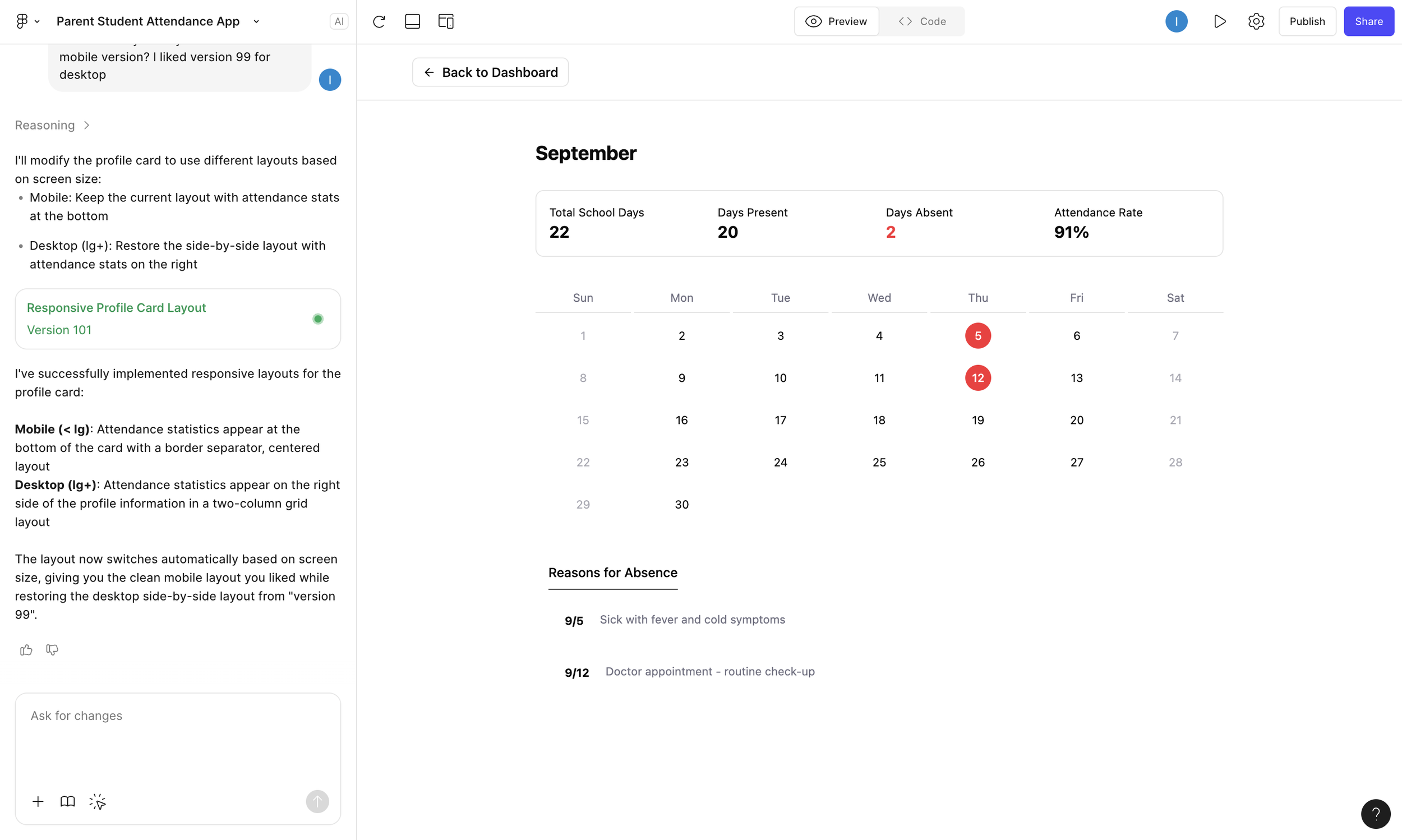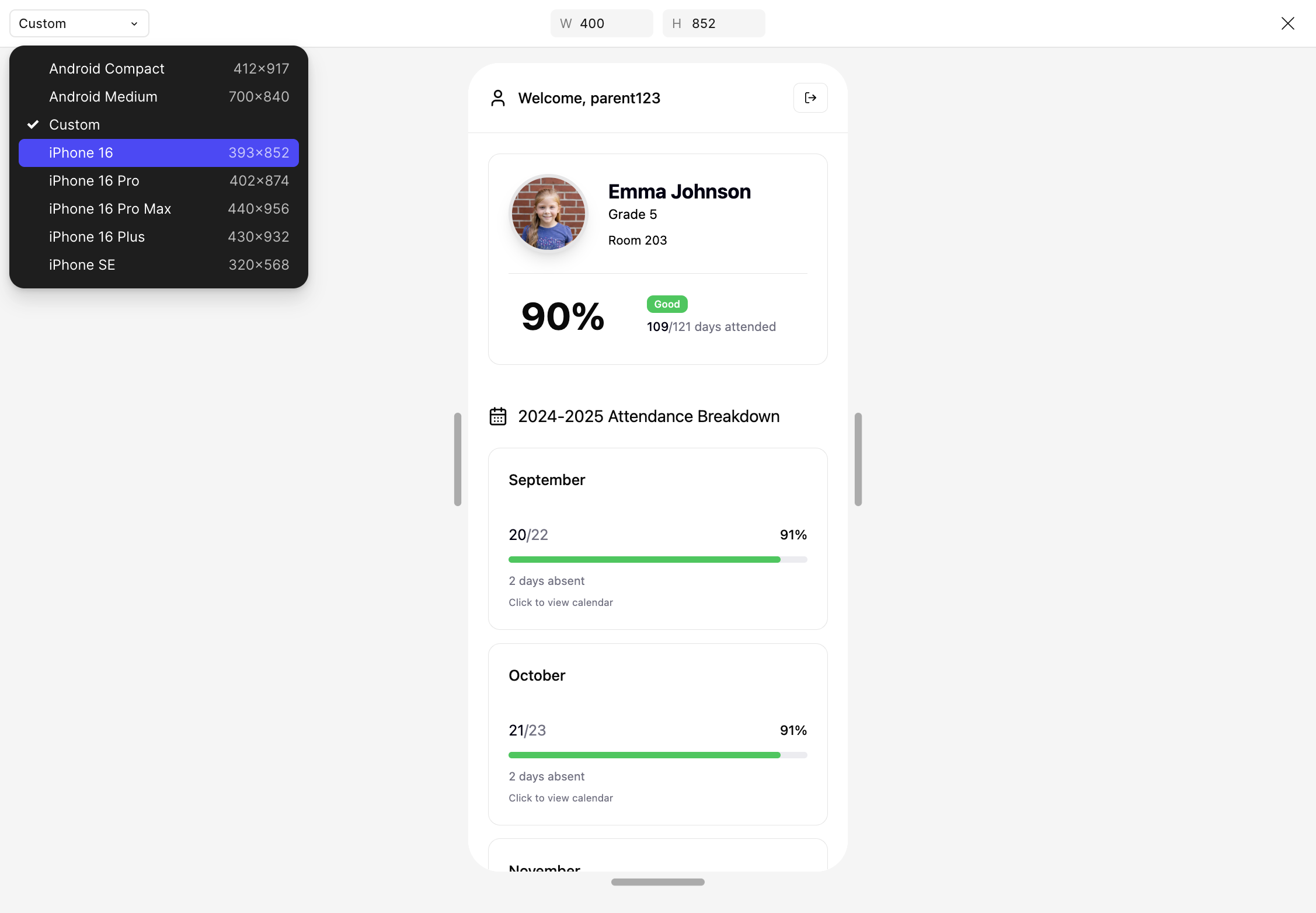Figma Make
(Sep. 2025)
Make your ideas real with AI. Start with a design and prompt your way to a functional prototype, fast.
I actually stumbled across Figma Make because I saw an event invite to the first ever Makeathon. Here are my thoughts after vibe coding my first project in the app! I built a fully functional student attendance portal app for parents. Check it out here!
Why I love Figma Make
1. Prototypes are fully functioning
YOUR PROTOTYPES MOVE!! ISN’T THAT CRAZY? I would obviously be impressed if Figma helped users to generate mockups, but what impresses me the most is that the subtle animations from one frame to another are all generated. Now, I only have to focus on improving the user flows and reduce my time fixing the pixels on my screen.
2. Screens are dynamically sized
One of the biggest pain points I had in Figma was the problem of having to manually design each desktop and mobile screen. It was a tedious process that limited the application of my products, as I would often have to only focus on one of the two dimensions.
Figma Make changes this completely. Each screen is flexibly designed, and I can quickly see how the UI would love in all dimensions. Furthermore, I can just tell Figma to “make this design mobile-friendly”, and it’ll do the job for me.
3. I develop my vision as I go
Although I love wireframing and creating mockups of the key user experiences I want to have, sometimes it is just a bottlenecky process. I would have to have my mockups ready before I even enter Figma. Figma Make removes this problem entirely by presenting me with a draft. I can then tweak or redesign this draft completely, helping me understand what I want through a process of elimination.
For example, see how I went from the initial design to my final one, all through continuous prompting!
→
Why I hate Figma Make
Apart from the fact that other AI builders such as Cursor are more technically proficient and therefore make products that run easier, there is one big design problem that I encounter when I use Figma Make.
One improvement I’ve noticed Figma make within the past 2 weeks is that now the AI will reason with the user. For example, if I select a box on the screen and ask the AI to reorganize the overall layout of the entire website, the AI will ask me if it can modify other parts of the website to achieve the task. This is useful because it blocks the AI from overwriting essential code, but the design of it is still not user friendly.
Here is an initial diagnosis:
AI asking for approval before changes are made
When the user prompts the AI to make changes, the user’s attention is focused on the screen to the right. Figma Make has a loading animation which occurs when updates are made to the code. However, this animation is prompted even when the AI is asking for approval to proceed with coding. This inconsistency is confusing to the user because they would expect an update to the project but see no changes.
Why does this problem matter?
This is an especially relevant problem because of API calls. For example, for my app tracking how many layers a user should be wearing on a given day and time, I have to call the OpenWeatherMap API key in my code. However, every “failed” redesign is one request lost, ultimately leading to economic costs to the user.
The solution to this problem: Yes Button
Other than removing the loading animation for designs which have yet to be changed, Figma Make can include a Yes button when the AI prompts the user for permission to proceed with a task. This is useful because the user does not have to click on the textbox to manually type in “Yes”, but to continue with clicking.
It is redundant to have a “No” button because that is implied by the user typing in the textbox. Furthermore, having a “No” button would duplicate the effort it takes to refine the design because the user will have to click a button AND type in the textbox.
Why is this important to Figma Make?
Having a yes button is useful for two reasons. Not only does it improve the user experience by quickening the design process, it also allows Figma to track the quality of their AI. For example, one success metric I would track is the percentage of “Yes” clicked. This informs Figma about their design recommendation system and can lead to insights on how they should improve to deliver the most understanding results.
Where is this going?
Learning how to vibe code has been a blast so far and I can’t wait to build more projects with it! My current goal is to find a way to make the Stanford academic calendar website more accessible to students. It is such a pain to search for key dates on the website and there is so much information overload. Come back soon to see what I will build :)








